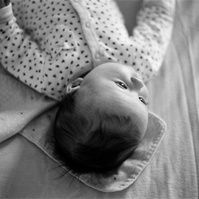As some of you know, my wife and I welcomed our first child into the world way back in November. Fast forward almost four months, we have a tiny little person that is finding her vocal cords.
Years ago my parents got me a roll of Ilford FP4 film for Christmas and it’s more or less been the only black and white film I’ve used since then. For colour I have some Fuji Velvia and Kodak Ektar kicking around that, after this little project, might be used sooner rather than later.
The tricky thing with film nowadays is the processing. Since digital has taken over, finding a place to process film can be challenging. Luckily there’s Old School Photo Lab located in Dover, New Hampshire. They’re a fantastic little lab where I’m going to be a customer for life. You send them your film, they process it, print it (if you want), and even offer high-res scans. Processing and scanning for this roll was something like $22 USD. Totally reasonable.
Anyhow, I recently shot a roll of black and white film of our daughter. I keep my stocks in my freezer and for quite a while wanted to use one on her. I don’t shoot a lot of film, but occasionally it’s a fun little thing to do that requires you to think just a little bit more before you shoot. By that I mean you can’t really just blast off a bunch of frames knowing that if one doesn’t turn out, surely there’ll be a few others that did. Even when shooting digital I’ve really tried to limit myself and make sure I don’t overshoot things even if I can shoot hundreds upon hundreds of photos in a day. I’m not saying don’t shoot a lot. My point is that you need to shoot with purpose; don’t take photos for the sake of taking photos.
I like the pace of shooting film; it’s calming and stressless. You don’t get the instant gratification that digital offers and, to me, it makes seeing the results that much better. You’ve got a finite amount of frames to use up with film. In this case, I had 36 exposures, not a 32 GB memory card.
The second instalment of FlashWR was this past weekend. I had a previous engagement that I had to be at so I was unfortunately unable to attend. Kind of a bummer, but that’s what happens when you double-book yourself. I remember last year having a blast at the event so it was tough knowing I couldn’t be there.
Anyhow, the format this year was slightly different. Photographers were allowed to submit up to three photos instead of just one. Each of those photos were eligible to be selected by the jury. In total there were approximately 400 images submitted, of which 50 were selected to be projected on the big screen.
I was pretty humbled that two of the three images I submitted were accepted. My selected photos were of an underpass as well as the façade of an office building, both here in town.
Like last year, there were three featured photographers. This year’s trio included Sean Puckett, Alioscia Hamma, and Stan Rosenthal. Sadly, Stan passed away shortly after being selected. I’ve been fortunate to meet all three of these photographers so it was nice to see more of their work and hear them speak about their craft. Big thanks to Gordon Hatt for uploading the videos to YouTube after the show.
The headliner this year was Camille Seaman, a native american photographer and TED fellow who has become famous for her portraits of melting icebergs in the Earth’s polar regions. From my friends that attended, they all came away rather inspired after hearing Camille speak. Luckily I was able to get my copy of her book, ”Melting Away”, signed by her (thanks, Mike!).
Flash appeared to be another roaring success this year; I have to make sure I make it a priority next year.
The 2016 edition of Leadership Waterloo Region’s Fire & Ice Gala was held over the weekend. It was my fifth time as one of the featured artists that had some work up for auction. I’ve had great success at past galas, and including this one now, I’ve sold at least one piece at each event.
As in previous years, the artist sets the reserve price for their work and the attendees bid as they wish. Once that reserve price is met, the piece has been sold and the artist gets paid. Yahoo! If bidding continues, Leadership Waterloo pockets anything above and beyond that reserve bid. Everyone wins really; the artist gets paid, Leadership Waterloo gets paid, and the bidder gets some new art for their home or office.
This year I had a photo of CIGI in Waterloo as well as one of my most photographed buildings in the region, The Perimeter Institute. The PI building is a favourite and it seemed popular when I shared it on Instagram a while back.
The PI shot went slightly above the asking price while the CIGI shot is now in my attic for the time being since it didn’t receive any bids, but I’m quite happy I was able to get some money to Leadership Waterloo Region in the process.


























